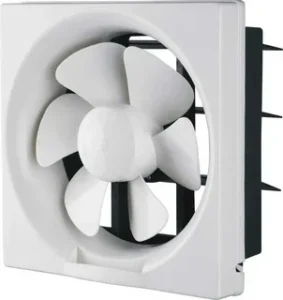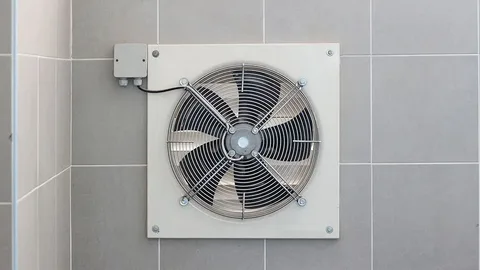A Ventilation fan plays a crucial role in maintaining indoor air quality and promoting comfort within buildings. These fans are essential components of HVAC (Heating, Ventilation, and Air Conditioning) systems, designed to circulate and exchange air, thereby removing pollutants, moisture, odours, and airborne contaminants. In residential settings, they are commonly found in bathrooms and kitchens, where they effectively remove excess humidity from showers and cooking vapours, preventing mould growth and maintaining a healthier environment.
Understanding the Importance of Proper Ventilation in Your Home
Proper ventilation in your home is crucial for maintaining a healthy and comfortable living environment. Ventilation refers to exchanging indoor air with outdoor air, which helps remove indoor pollutants, control moisture levels, and regulate indoor temperatures. Here are several key reasons why proper ventilation is essential:
- Air Quality: Effective ventilation reduces indoor air pollutants such as volatile organic compounds (VOCs), dust, allergens, and other airborne particles. These pollutants can originate from cooking, cleaning chemicals, furniture, and building materials. Continuous ventilation ensures fresh outdoor air dilutes and removes these harmful substances, promoting better indoor air quality.
- Moisture Control: Proper ventilation helps manage moisture levels inside your home. Excess moisture can lead to mould and mildew growth, which damages building materials and poses health risks to occupants. In bathrooms, kitchens, and basements, where moisture levels tend to be higher, these fans or systems are essential to remove humid air and prevent condensation.
- Temperature Regulation: Ventilation contributes to maintaining comfortable indoor temperatures year-round. In hot weather, proper ventilation can help expel warm air and bring in cooler outdoor air, reducing the need for extensive air conditioning. In colder months, ventilation helps remove stale indoor air and control humidity levels, preventing condensation on windows and walls.
- Health Benefits: Good ventilation improves respiratory health and overall well-being. Stale indoor air can exacerbate allergies and respiratory problems. At the same time, proper ventilation reduces the concentration of indoor pollutants and provides a steady supply of fresh air, essential for respiratory function and overall health.
The Role of Ventilation Fan
The role of a ventilation fan is pivotal in maintaining indoor air quality and ensuring a healthy and comfortable environment within homes and buildings. These fans are designed to facilitate air exchange by drawing out stale, polluted indoor air and bringing in fresh outdoor air. Here are several key roles and benefits of these fans:
- Air Circulation and Exchange: These fans actively circulate air, crucial for reducing indoor pollutants such as volatile organic compounds (VOCs), allergens, dust, and other contaminants. By continuously exchanging indoor air with outdoor air, these fans help dilute and remove these pollutants, improving indoor air quality.
- Moisture Control: In areas prone to moisture buildup, such as bathrooms, kitchens, and basements, these fans play a critical role in moisture control. They help remove humid air, reducing the risk of mould and mildew growth. Proper ventilation can also prevent condensation on windows and walls, leading to structural damage and mould issues.
- Odour Removal: These fans effectively remove unpleasant odours from cooking, pets, smoke, and other sources. By exhausting indoor air to the outside and bringing in fresh air, these fans help maintain a more pleasant and odour-free indoor environment.
How to Identify and Address Common Ventilation Issues
As we go about our daily lives, it’s easy to overlook the importance of proper ventilation in our homes. However, neglecting this crucial aspect of indoor air quality can seriously affect our health, safety, and comfort. From musty odours and stale air to mould growth and respiratory issues, ventilation issues can manifest in various ways. However, identifying and addressing these problems is crucial to creating a healthy and welcoming living space.
Common ventilation issues can arise from various factors, including inadequate airflow, poor design, and worn-out systems. For example, a bathroom with inadequate ventilation can lead to mould and mildew on surfaces and walls, while a kitchen with poor ventilation can build up cooking fumes and grease.
Similarly, a home with a poorly designed ventilation system can lead to uneven air pressure, which can cause doors and windows to stick or even lead to structural damage. By taking the necessary steps to identify and address ventilation issues, you can create a healthier, safer, and more comfortable living space that you and your family can enjoy for years to come.
 The Importance of Air Exchange Rates and Ventilation Systems
The Importance of Air Exchange Rates and Ventilation Systems
Proper ventilation in your home is not just a matter of opening a window or turning on a fan. Still, it’s a delicate balance of air exchange rates and ventilation systems that work together to create a healthy, safe, and comfortable living environment. The air exchange rate, measured in air changes per hour (ACH), is the rate at which stale air is replaced with fresh air. A well-designed ventilation system aims to maintain a consistent air exchange rate, ensuring that the air in your home is constantly being refreshed and renewed.
A ventilation system designed to provide a sufficient air exchange rate can profoundly impact your family’s overall health and well-being. Removing stale air and pollutants can reduce the risk of respiratory problems, headaches, and other health issues. Additionally, a well-ventilated home can help prevent the buildup of moisture, leading to mould and mildew growth. This is especially important in areas with high humidity, such as bathrooms and kitchens.
In terms of safety, a ventilation system designed to provide adequate air exchange can also help reduce the risk of carbon monoxide poisoning. By removing stale air and bringing in fresh air, a ventilation system can help dilute any hazardous gases that may be present in the air, providing a safer environment for your family.
The importance of air exchange rates and ventilation systems cannot be overstated. A well-designed ventilation system can significantly impact the health, safety, and comfort of your home by providing a consistent and sufficient air exchange rate.
When to Hire a Professional for Ventilation System Installation
This article emphasises that proper ventilation is crucial for maintaining a healthy, safe, and comfortable living space. However, not everyone may have the expertise or resources to tackle a ventilation system installation independently. In such cases, it’s essential to know when to seek the help of a professional.
When dealing with a complex ventilation system, such as a whole-house ventilation system, hiring a professional with the necessary training and experience to get the job done correctly is crucial. This is especially true if you deal with intricate ductwork, multiple levels, or unusual building designs. Your ventilation system may not function efficiently without proper installation, leading to poor air quality, increased energy bills, and potential safety risks.
Additionally, suppose you’re dealing with a ventilation system that requires integration with other HVAC systems, such as heating and cooling units. In that case, hiring a professional who can ensure seamless integration and optimal performance is crucial. They will have the necessary knowledge to design and install a system that meets your needs and provides the best air quality and indoor climate.
If you’re unsure about the complexity of your ventilation system or lack the necessary expertise to install it, it’s always best to hire a professional who can provide you with expert guidance and installation. This will ensure a safe and efficient installation and give you peace of mind, knowing that your ventilation system is functioning at its best.
The Benefits of Using Whole-House Ventilation Systems
As discussed in previous sections, proper ventilation is crucial for maintaining a healthy, safe, and comfortable living environment. While point-of-use ventilation systems, such as exhaust fans and heat recovery ventilation, can effectively address localized issues, they often fail to provide comprehensive ventilation solutions. It is where whole-house ventilation systems come into play. These sophisticated systems eliminate the need for multiple disparate ventilation units, providing a centralized and integrated approach to air circulation.
Whole-house ventilation solutions can efficiently exchange stale indoor air with fresh outdoor air by utilizing a single, high-capacity system, eliminating the need for multiple units and associated energy consumption. This enhances indoor air quality and reduces the risk of moisture buildup, which can lead to mould growth, structural damage, and other issues.
Moreover, whole-house ventilation systems can be tailored to meet your home’s unique needs. For example, they can be designed to incorporate heat recovery, where heat from the exhaust air is transferred to the fresh air supply, reducing the load on your heating and cooling systems. This can lead to significant energy savings and a more comfortable and consistent indoor climate.
How to Maintain and Clean Your Home’s Ventilation System
Maintaining and cleaning your home’s ventilation system is essential to ensuring the air you breathe is fresh, clean, and free from pollutants. Like any other machine, your ventilation system requires regular upkeep to function efficiently and effectively. A clogged or dirty system can lead to a buildup of allergens, bacteria, and mould, exacerbating respiratory issues and triggering asthma attacks.
To clean your ventilation system:
- Start by turning off the power to the system at the circuit breaker or fuse box.
- Remove any filters or grilles to access the ductwork.
- Use a vacuum cleaner or a specialized brush to remove any debris, dust, or dirt that may have accumulated.
- For more stubborn buildup, you may need to use a mild detergent and a soft-bristled brush to scrub the ducts gently. Avoid harsh chemicals or abrasive cleaners, as these can damage the system or air quality.
Following these simple steps lets you breathe easily, knowing your home’s ventilation system runs smoothly and efficiently.
Conclusion
In conclusion, ventilation fans are crucial in maintaining a healthy, comfortable, and energy-efficient indoor environment. By continuously circulating and exchanging air, these fans help remove indoor pollutants, control moisture levels, regulate temperatures, and eliminate unpleasant odours. It promotes better indoor air quality, reduces the risk of mould and mildew, and contributes to the overall well-being of building occupants. Whether in residential homes, commercial spaces, or industrial facilities, proper ventilation through fans is essential for creating environments where people can live and work comfortably while minimizing health risks associated with poor indoor air quality.
FAQS
What Are The Different Types Of Ventilation Fans?
Ventilation-fans include bathroom exhaust fans, kitchen range hoods, attic fans, whole-house ventilation systems, and specialty fans like inline fans used in ductwork. Each type serves a specific purpose: removing moisture, cooking odours, or heat from various building areas.
How Do Ventilation-Fans Help Improve Indoor Air Quality?
These fans continuously exchange indoor air with fresh outdoor air, diluting and removing indoor pollutants such as VOCs, allergens, dust, and mould spores. This process contributes to healthier indoor air quality.
What Is The Difference Between Exhaust Fans And Ventilation-Fans?
Exhaust fans are a type of fan specifically designed to expel stale air and pollutants from a specific area (e.g., bathroom or kitchen) to the outside. These fans, on the other hand, encompass a broader category, including exhaust fans and fans used in whole-house ventilation systems and other applications.
| Other Good Articles to Read |
| Gabrielle Blogs |
| Jason Toff Blogs |
| Thumb Blogs |
| Blog Shifter |
| Social Bookmarking Blogs |
| Blog Solidaire |
| Michael Coyne Blog |
| Born Free Blog |
| Oz Blog Hosting |
| Indepth News |
| Link Forum |
| Related Business Listings |
| Contact Directory |
| Local Business Profiles |

